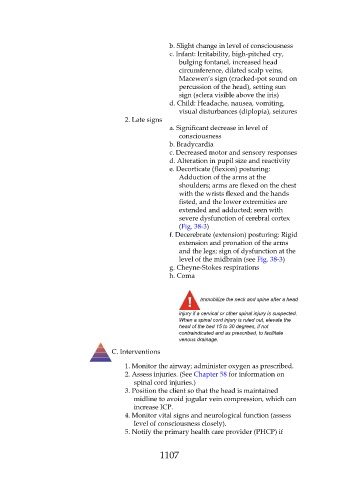Page 1107 - Saunders Comprehensive Review For NCLEX-RN
P. 1107
b. Slight change in level of consciousness
c. Infant: Irritability, high-pitched cry,
bulging fontanel, increased head
circumference, dilated scalp veins,
Macewen’s sign (cracked-pot sound on
percussion of the head), setting sun
sign (sclera visible above the iris)
d. Child: Headache, nausea, vomiting,
visual disturbances (diplopia), seizures
2. Late signs
a. Significant decrease in level of
consciousness
b. Bradycardia
c. Decreased motor and sensory responses
d. Alteration in pupil size and reactivity
e. Decorticate (flexion) posturing:
Adduction of the arms at the
shoulders; arms are flexed on the chest
with the wrists flexed and the hands
fisted, and the lower extremities are
extended and adducted; seen with
severe dysfunction of cerebral cortex
(Fig. 38-3)
f. Decerebrate (extension) posturing: Rigid
extension and pronation of the arms
and the legs; sign of dysfunction at the
level of the midbrain (see Fig. 38-3)
g. Cheyne-Stokes respirations
h. Coma
Immobilize the neck and spine after a head
injury if a cervical or other spinal injury is suspected.
When a spinal cord injury is ruled out, elevate the
head of the bed 15 to 30 degrees, if not
contraindicated and as prescribed, to facilitate
venous drainage.
C. Interventions
1. Monitor the airway; administer oxygen as prescribed.
2. Assess injuries. (See Chapter 58 for information on
spinal cord injuries.)
3. Position the client so that the head is maintained
midline to avoid jugular vein compression, which can
increase ICP.
4. Monitor vital signs and neurological function (assess
level of consciousness closely).
5. Notify the primary health care provider (PHCP) if
1107

